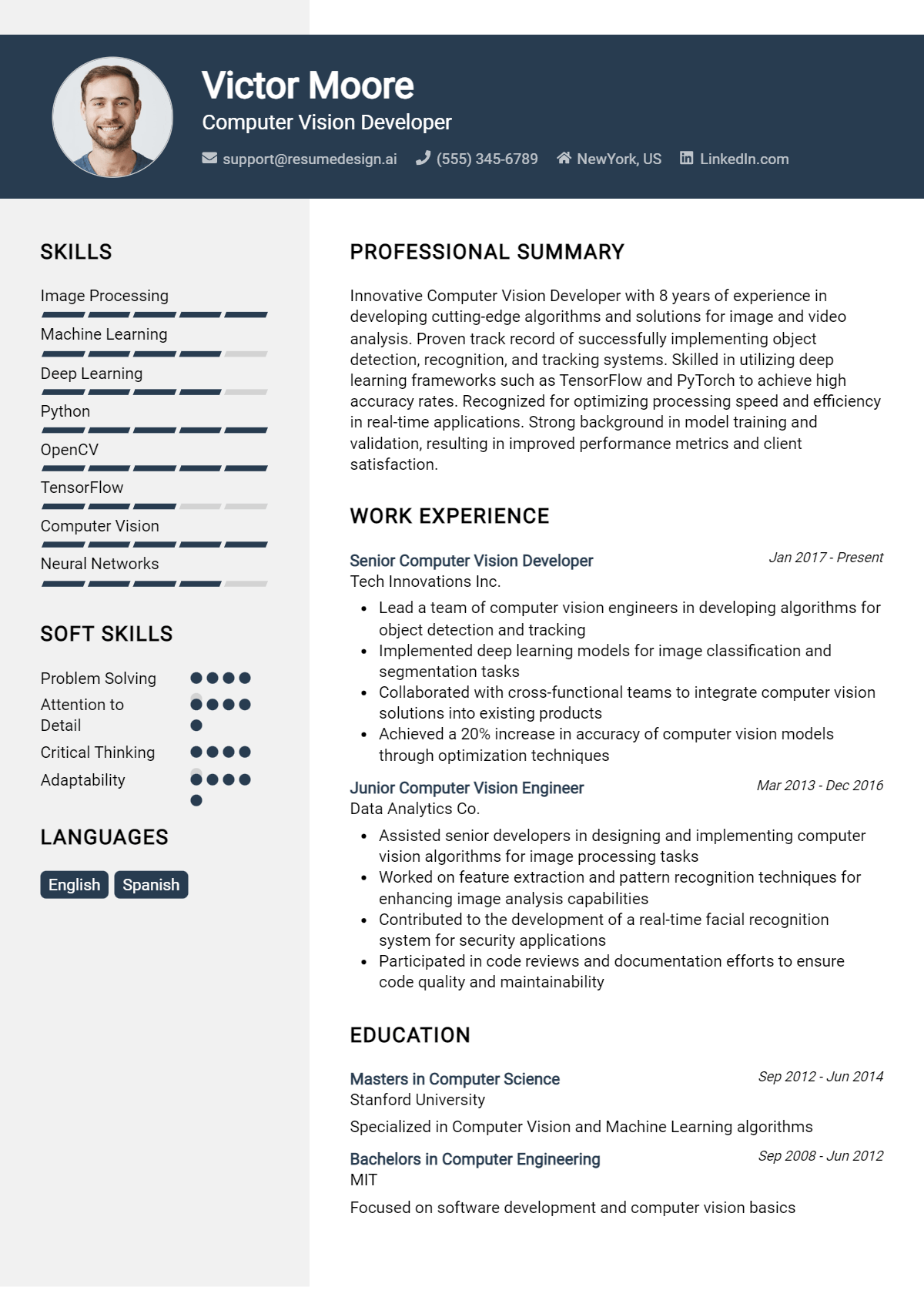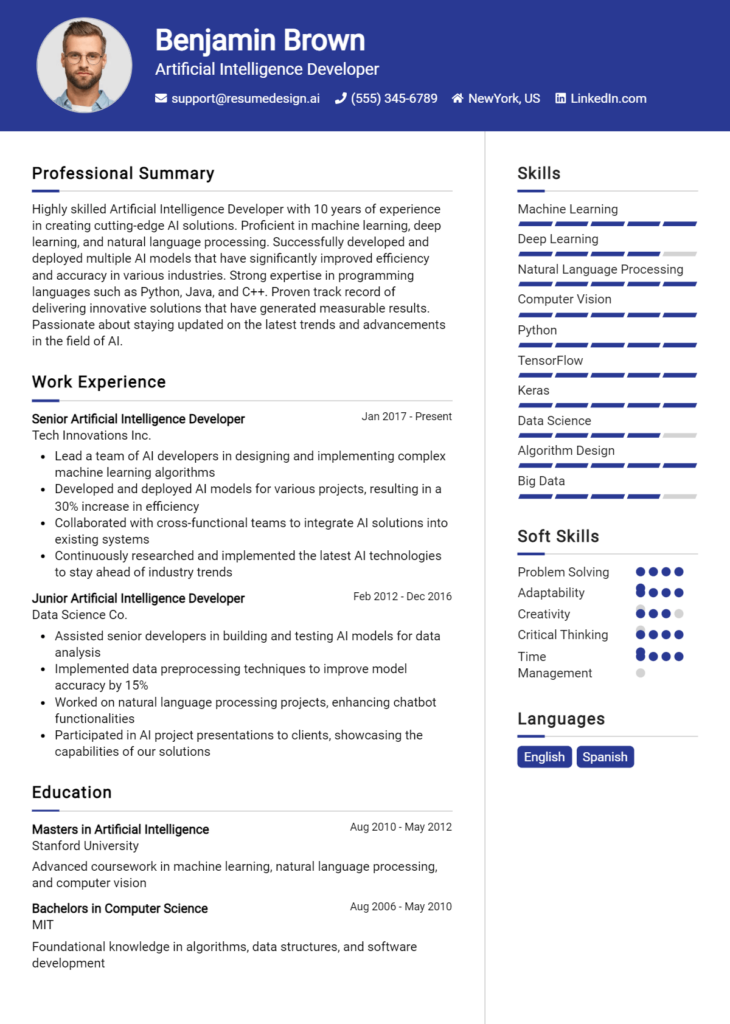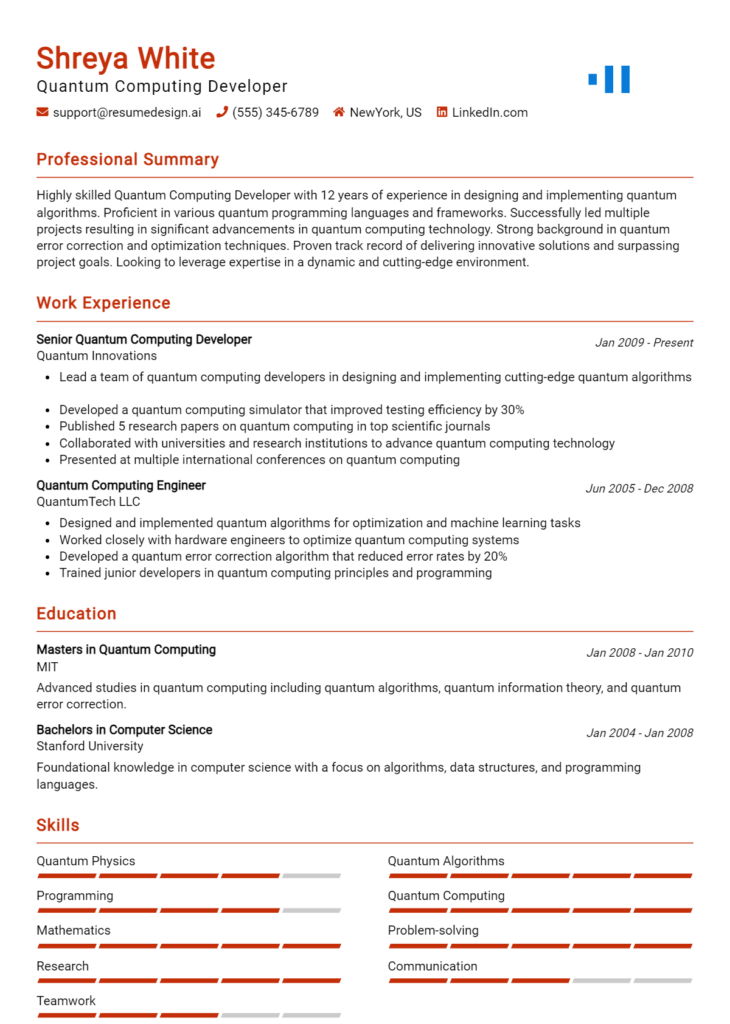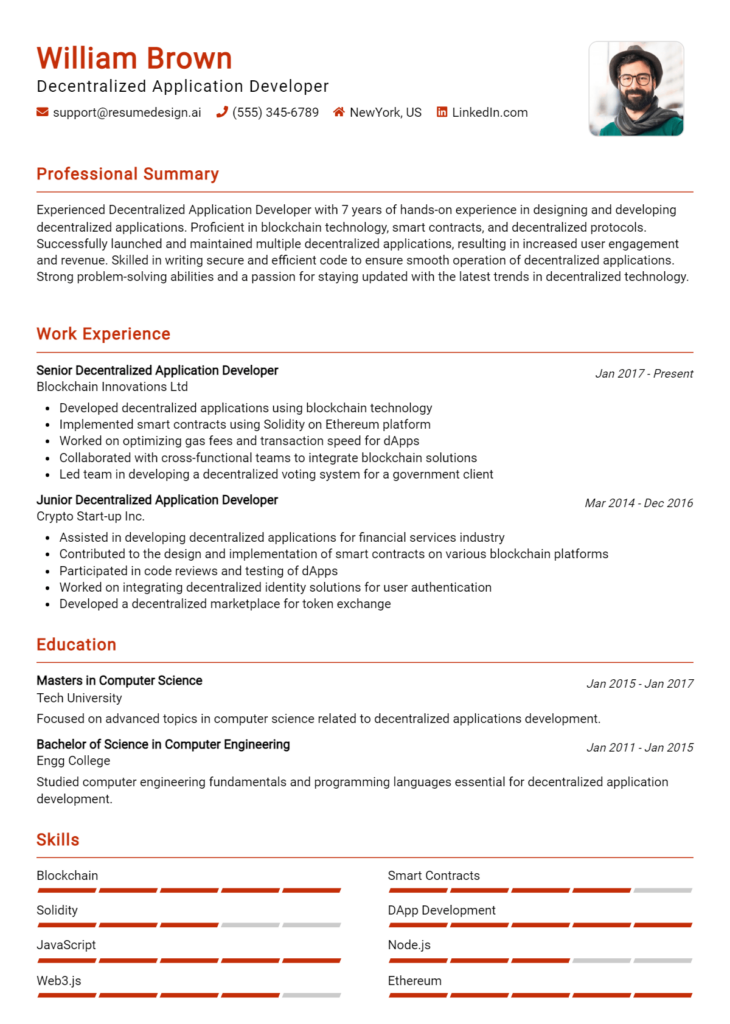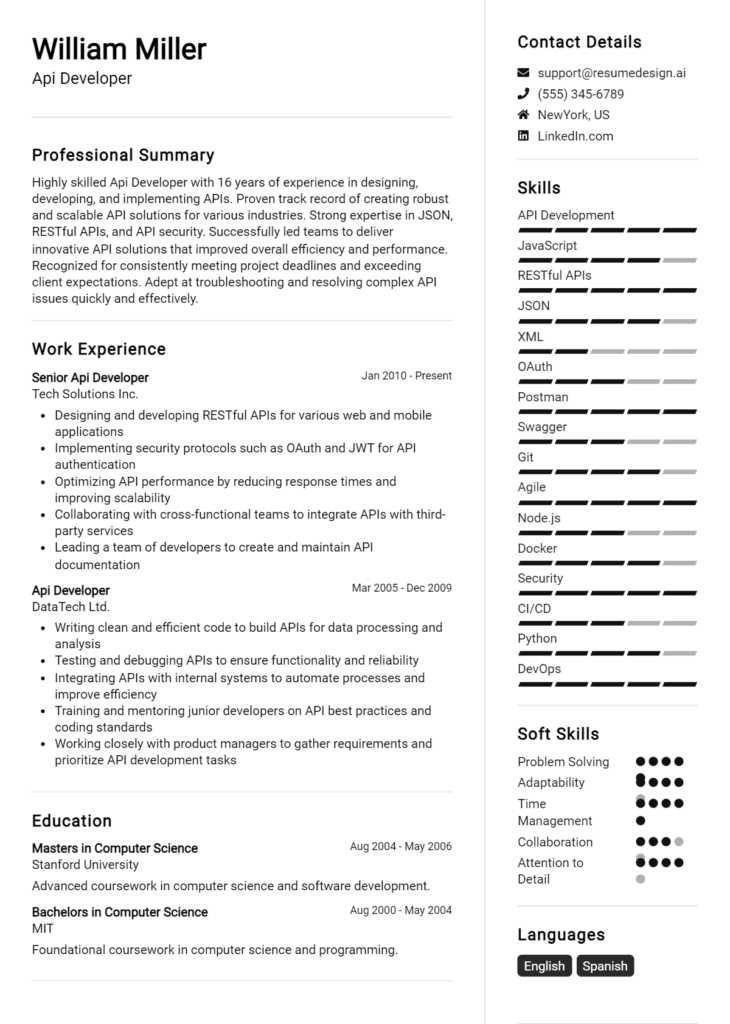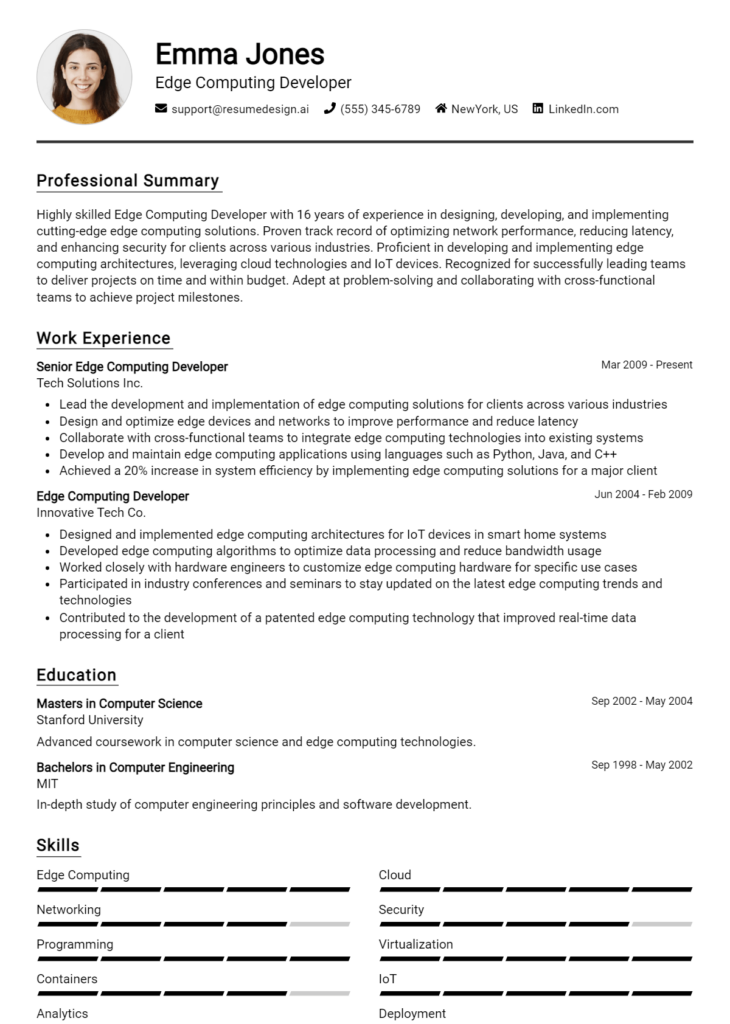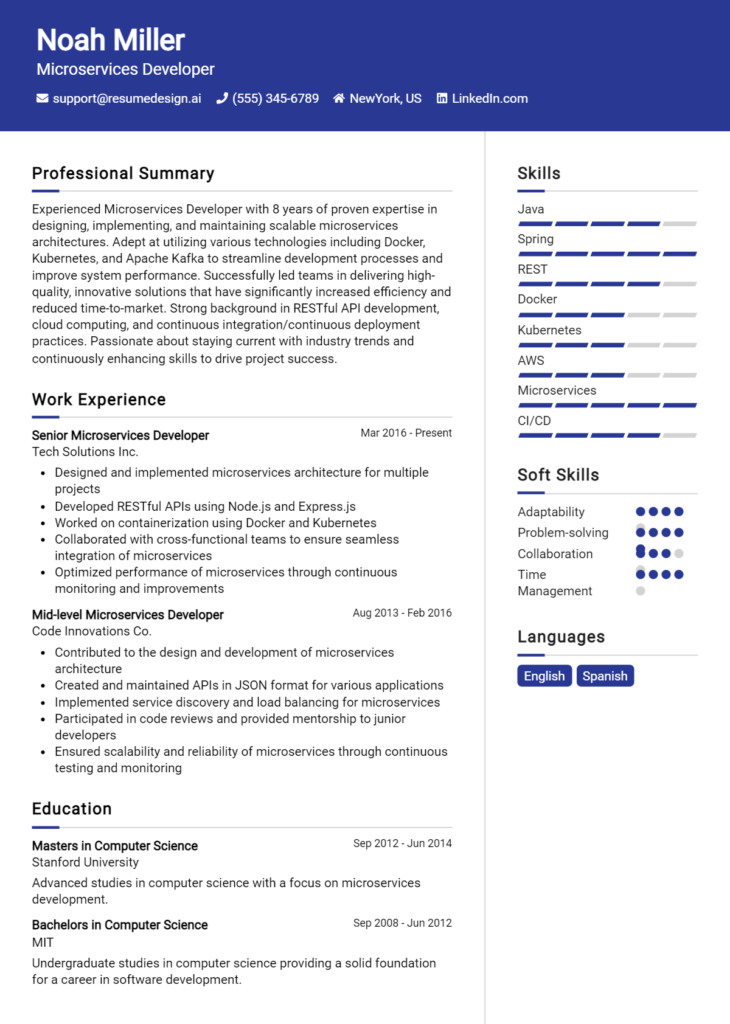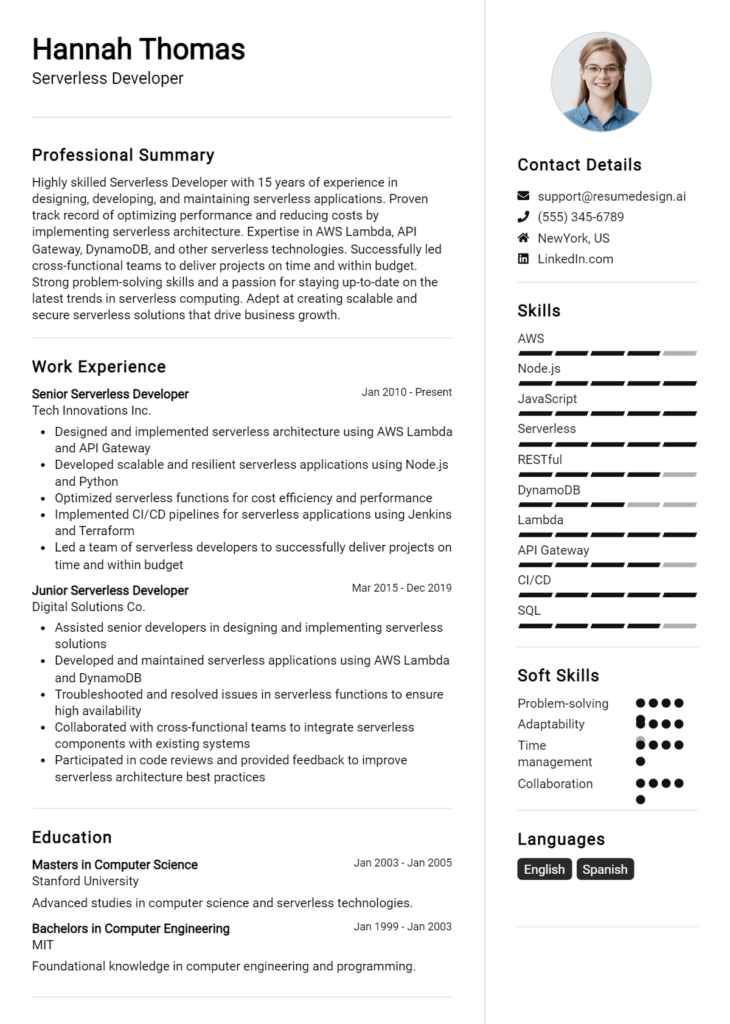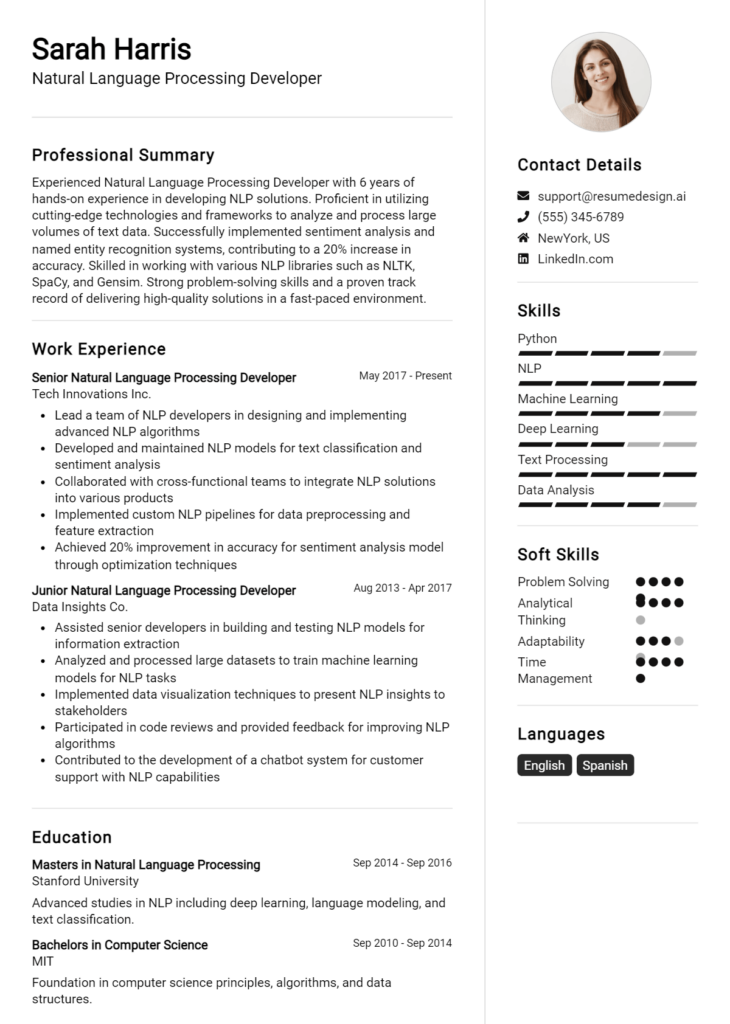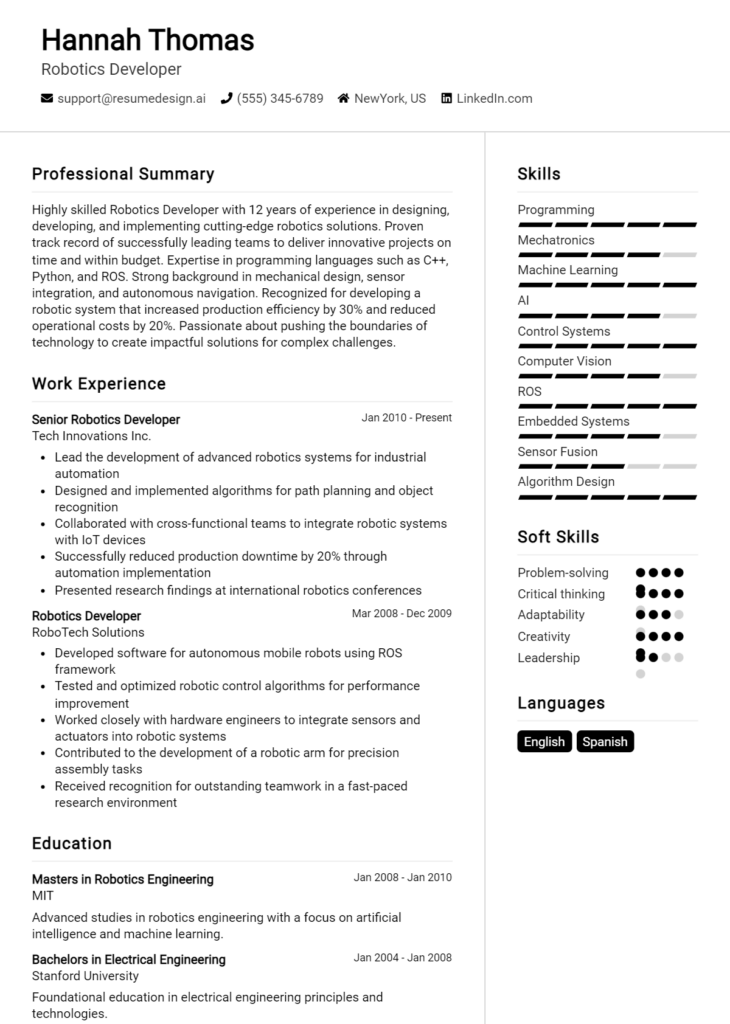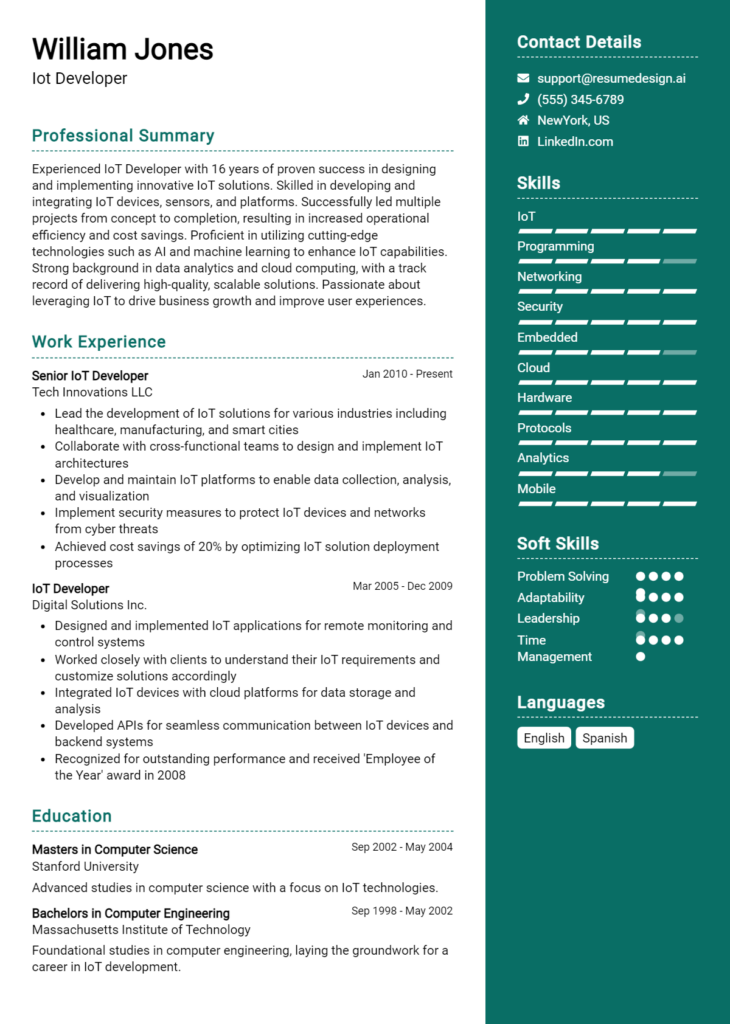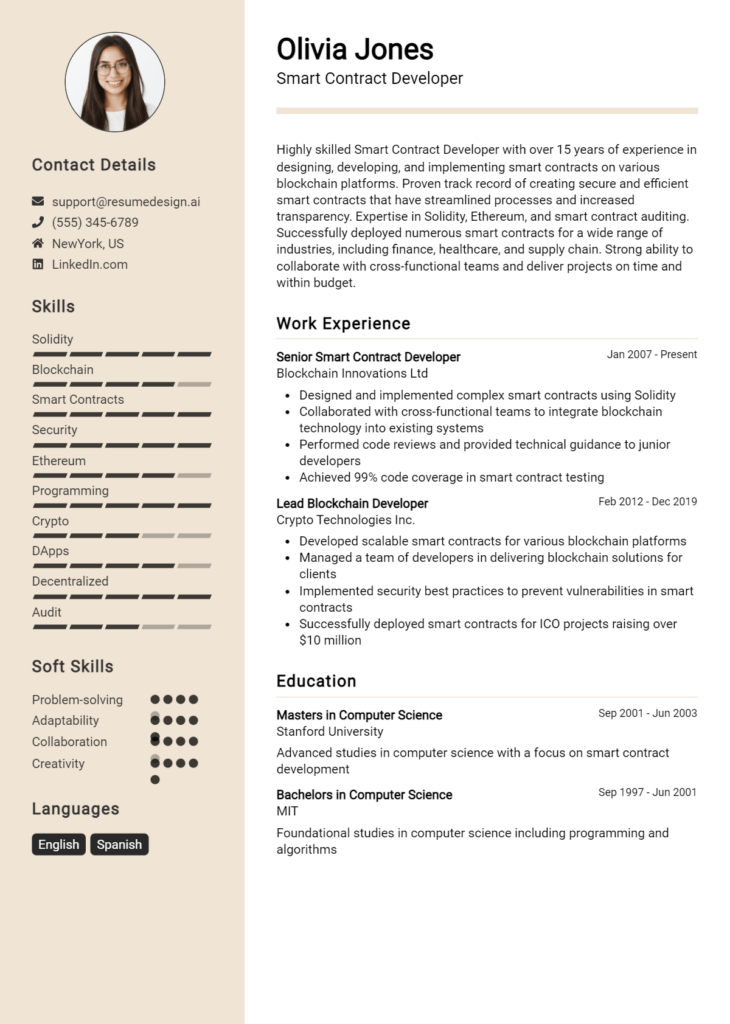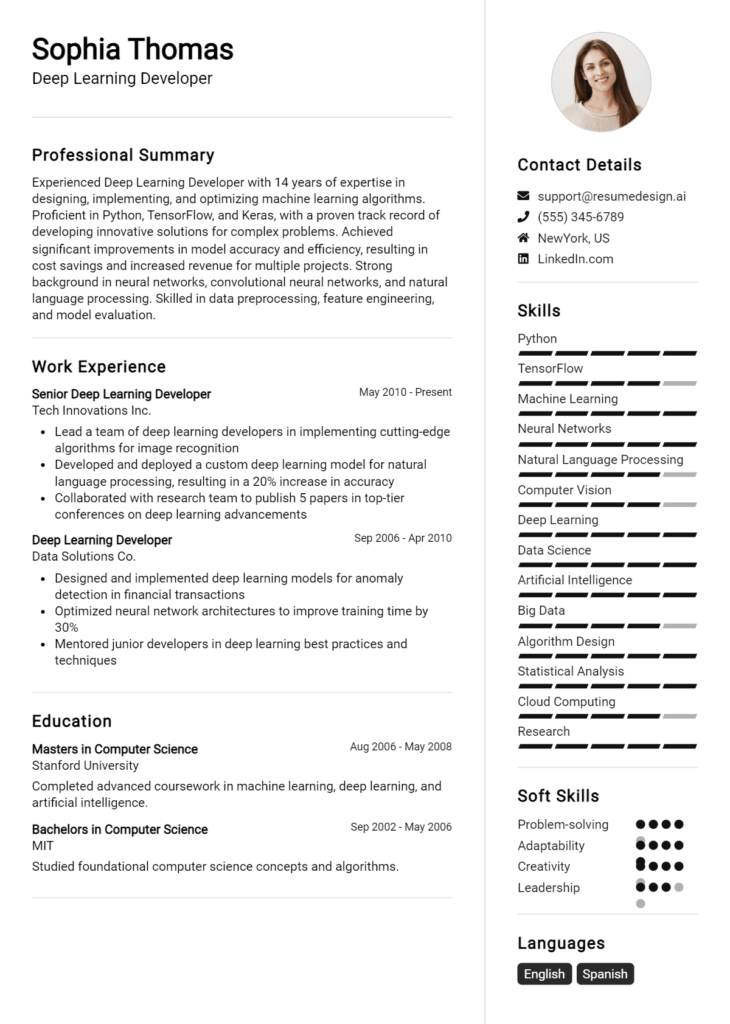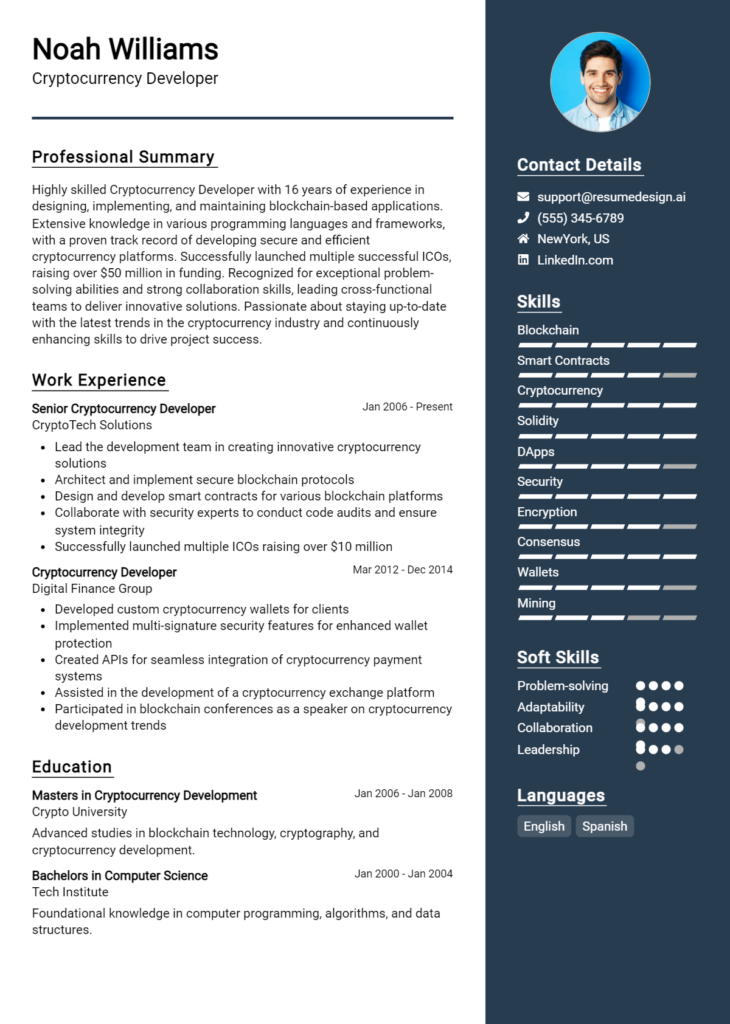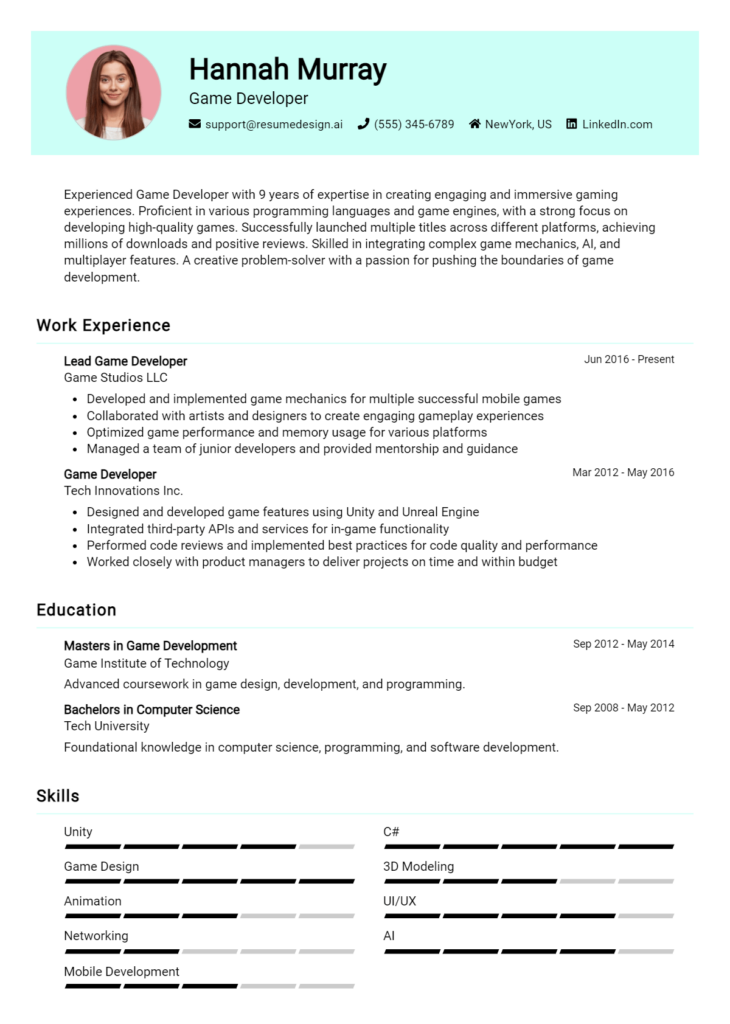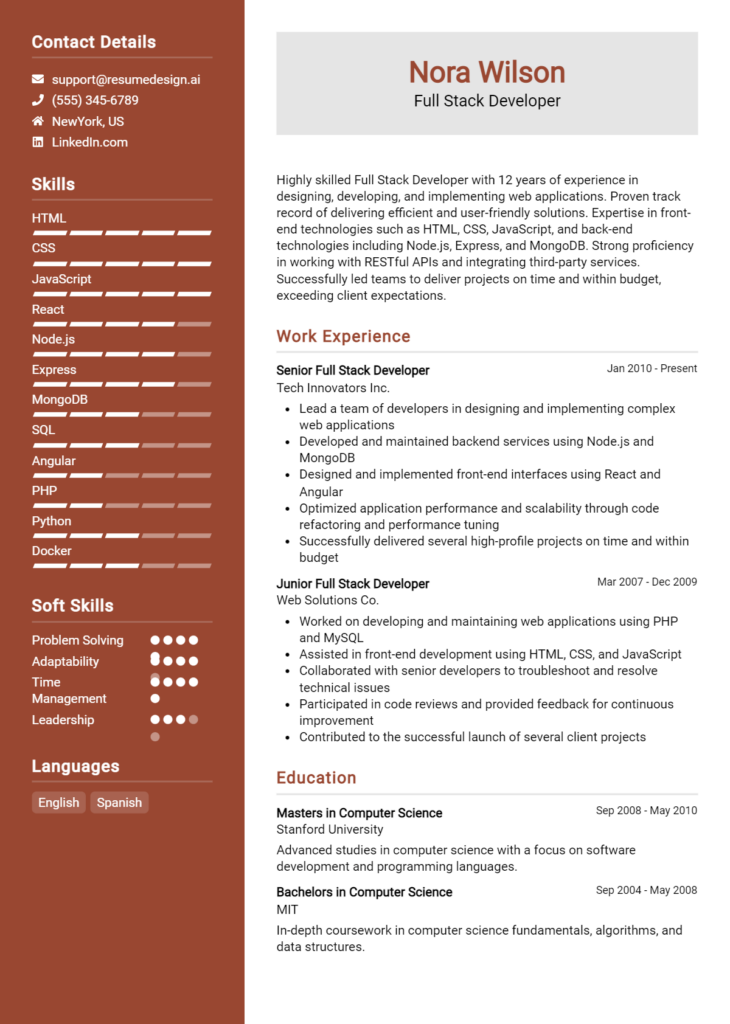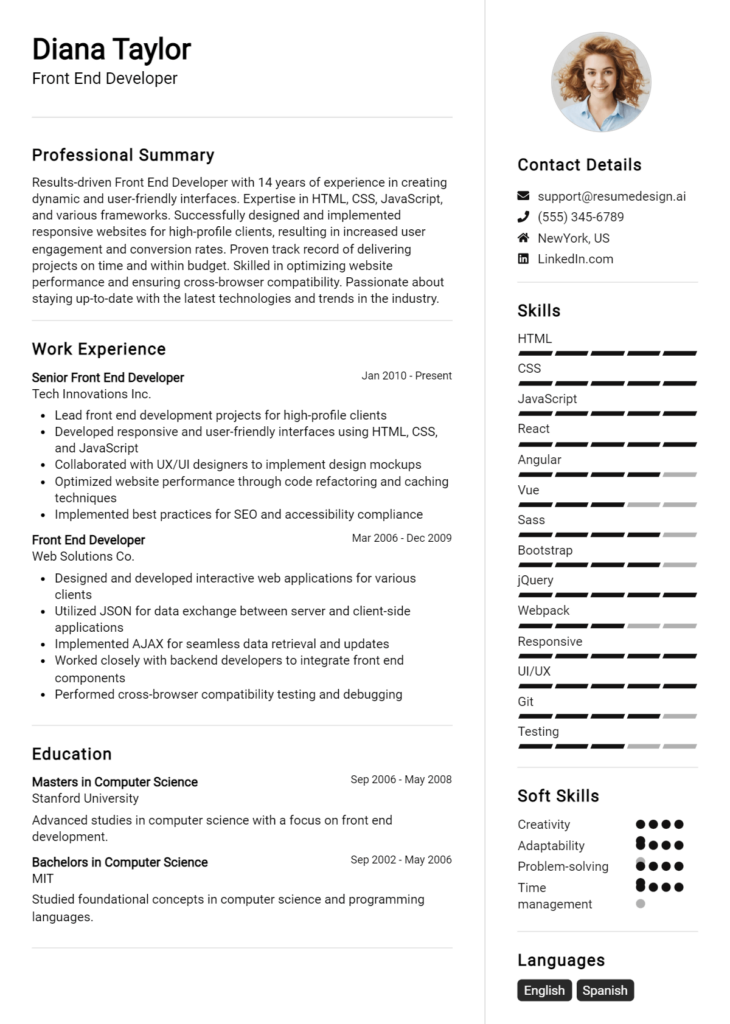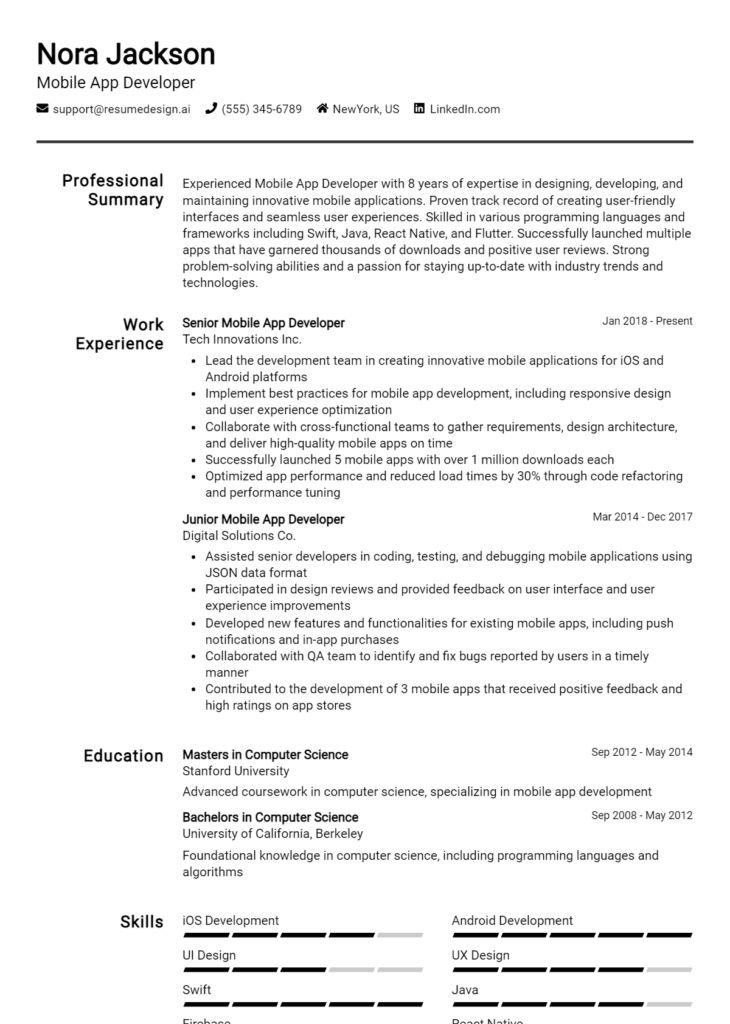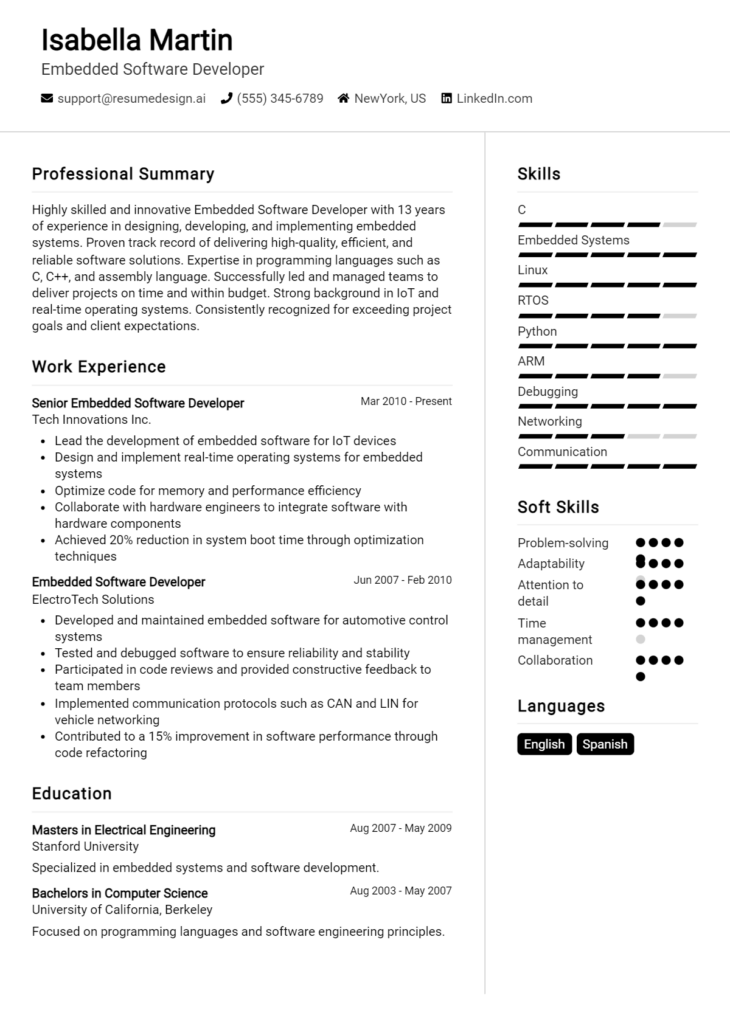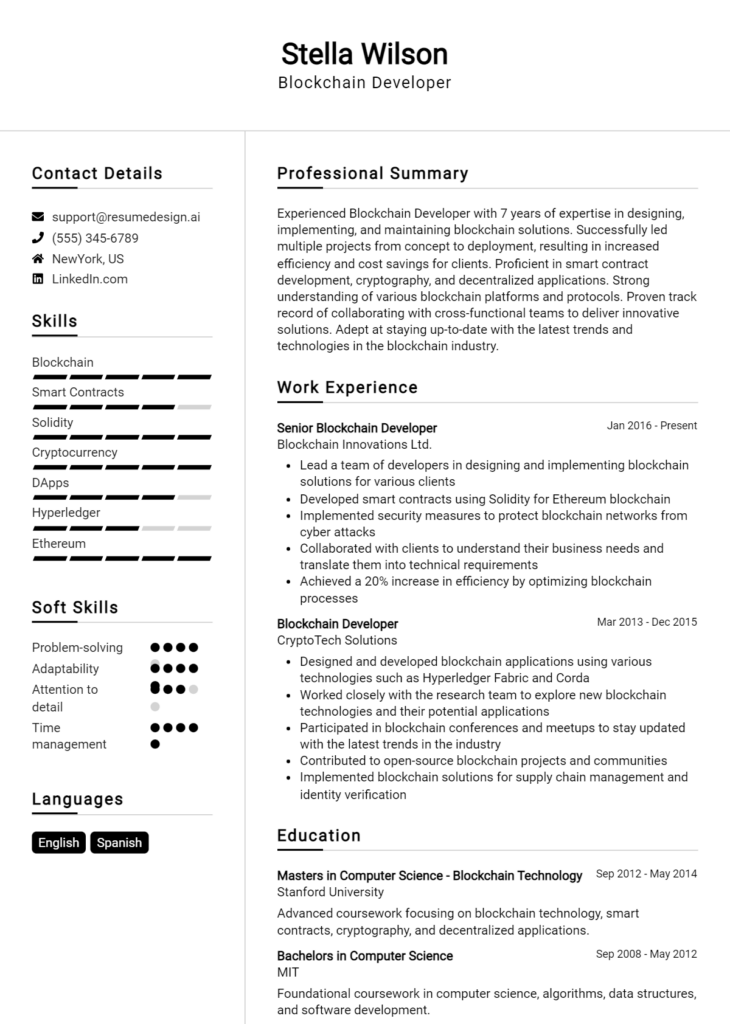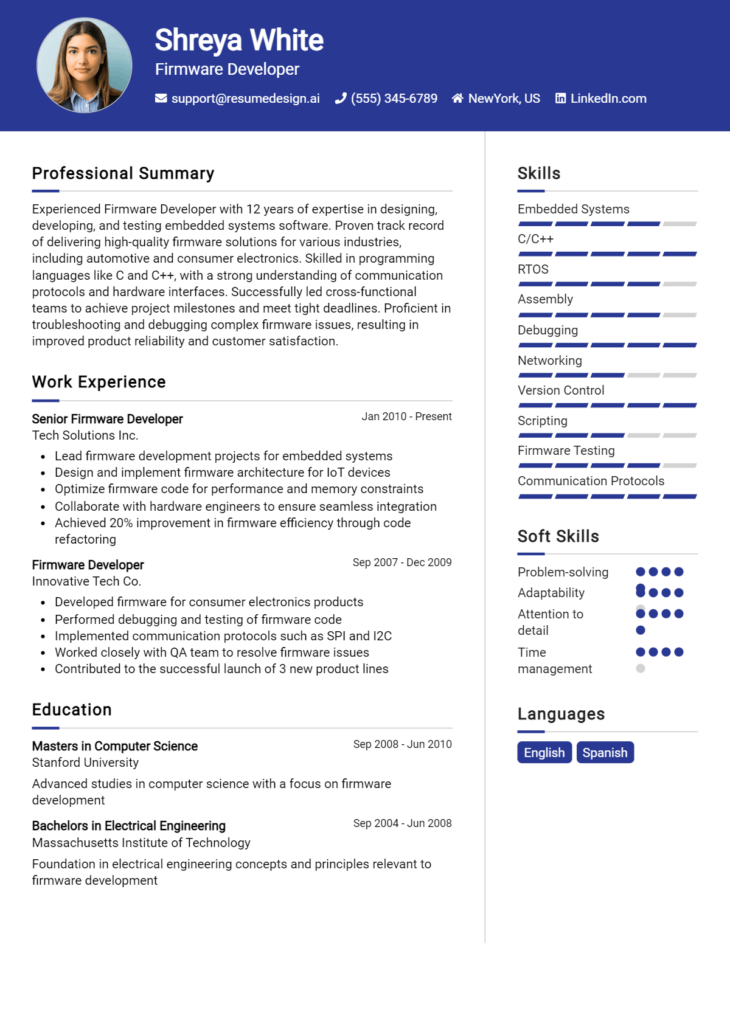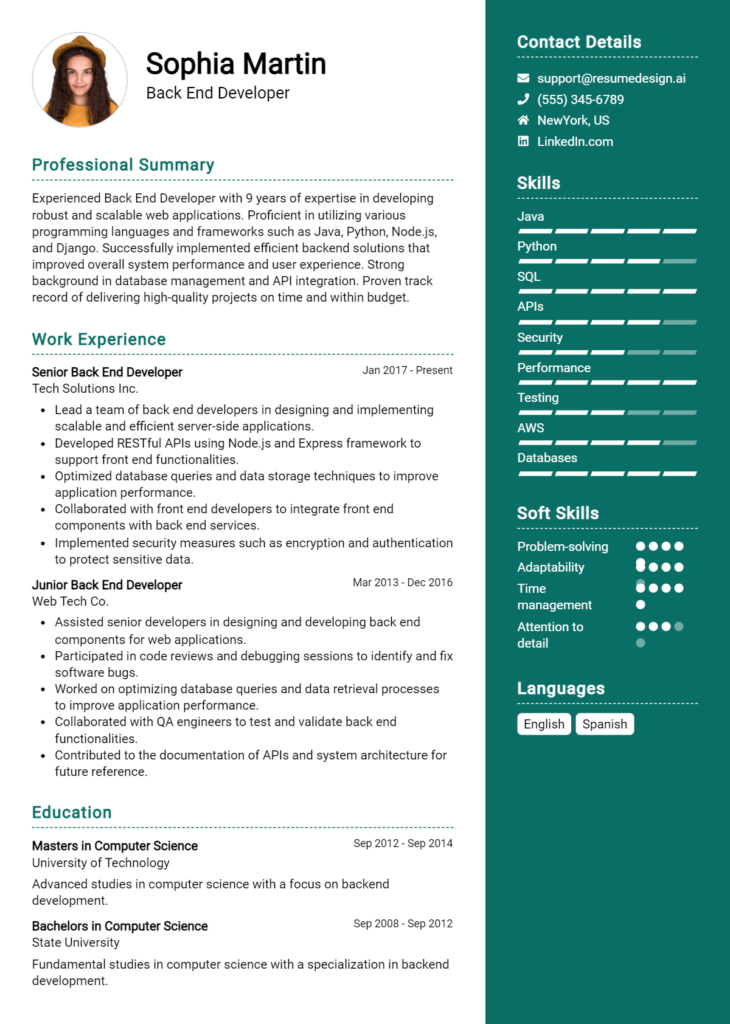Computer Vision Developer Core Responsibilities
A Computer Vision Developer is responsible for designing, implementing, and optimizing algorithms that enable machines to interpret visual data. Key skills include proficiency in programming languages like Python and C++, mastery of machine learning frameworks, and a strong foundation in mathematics and image processing. This role acts as a bridge between engineering, data science, and product management, requiring excellent problem-solving capabilities to address complex challenges. A well-structured resume can effectively highlight these technical and operational skills, demonstrating how they align with the organization's strategic goals.
Common Responsibilities Listed on Computer Vision Developer Resume
- Develop and optimize computer vision algorithms for image and video analysis.
- Collaborate with cross-functional teams to integrate vision systems into products.
- Conduct research to advance the state-of-the-art in computer vision techniques.
- Implement machine learning models for object detection and recognition.
- Design and maintain datasets for training and testing computer vision models.
- Evaluate performance metrics and improve algorithm efficiency.
- Utilize software development best practices for code quality and documentation.
- Provide technical support and troubleshooting for deployed vision systems.
- Stay updated on emerging technologies and trends in computer vision.
- Participate in code reviews and contribute to team knowledge sharing.
High-Level Resume Tips for Computer Vision Developer Professionals
In today's competitive job market, a well-crafted resume is essential for Computer Vision Developer professionals looking to make a lasting impression on potential employers. Your resume often serves as the first introduction to your skills, experience, and accomplishments, and it needs to effectively showcase your expertise in a field that combines technology and creativity. A strong resume not only highlights your technical skills and relevant experience but also communicates your achievements in a way that resonates with hiring managers. This guide will provide practical and actionable resume tips specifically tailored for Computer Vision Developer professionals, ensuring you stand out in this dynamic industry.
Top Resume Tips for Computer Vision Developer Professionals
- Tailor your resume to each job description by incorporating keywords and phrases that match the role's requirements.
- Highlight your relevant experience in computer vision projects, detailing your specific contributions and roles.
- Quantify your achievements with metrics where possible, such as "Improved image recognition accuracy by 20% through algorithm optimization."
- Showcase your proficiency in industry-specific tools and technologies, such as TensorFlow, OpenCV, and deep learning frameworks.
- Include a dedicated skills section that emphasizes both technical and soft skills relevant to computer vision development.
- Demonstrate continuous learning by mentioning certifications, courses, or workshops related to computer vision or machine learning.
- Use action verbs to describe your experience and achievements, making your contributions clear and impactful.
- Provide links to your portfolio, GitHub repositories, or any relevant projects that showcase your work in computer vision.
- Keep your resume concise and focused, ideally no longer than one page, to ensure clarity and readability.
By implementing these tips, you can significantly increase your chances of landing a job in the Computer Vision Developer field. A well-structured and targeted resume will not only highlight your qualifications but also demonstrate your understanding of the industry, making you a compelling candidate for potential employers.
Why Resume Headlines & Titles are Important for Computer Vision Developer
In the competitive field of computer vision development, a resume headline or title plays a crucial role in capturing the attention of hiring managers. A well-crafted headline serves as the first impression a candidate makes, providing a succinct summary of their key qualifications and expertise. It should be concise, relevant, and tailored to the specific job being applied for, allowing the candidate to stand out from the crowd. A strong headline not only highlights essential skills and experience but also sets the tone for the rest of the resume, making it an invaluable component of any successful job application.
Best Practices for Crafting Resume Headlines for Computer Vision Developer
- Keep it concise: Aim for one impactful phrase that conveys your expertise.
- Be role-specific: Tailor the headline to match the job title you are applying for.
- Highlight key skills: Include essential skills relevant to the position, such as machine learning or image processing.
- Showcase experience: Mention years of experience or notable accomplishments if applicable.
- Use industry keywords: Incorporate terms that are commonly used in the field of computer vision.
- Avoid generic language: Steer clear of vague terms that do not convey your unique strengths.
- Maintain professionalism: Ensure the tone is appropriate for a technical role in a corporate environment.
- Revise for clarity: Edit your headline to ensure it is clear and free from jargon that may confuse the reader.
Example Resume Headlines for Computer Vision Developer
Strong Resume Headlines
Innovative Computer Vision Developer with 5+ Years in Machine Learning and Image Recognition
Experienced Computer Vision Specialist Skilled in Deep Learning and Automated Image Analysis
Results-Driven Computer Vision Engineer with Proven Track Record in Building Scalable Vision Solutions
Weak Resume Headlines
Computer Vision Developer
Experienced Professional Looking for Opportunities
The strong headlines are effective because they clearly convey the candidate's specific skills and achievements, allowing hiring managers to quickly understand their qualifications. They utilize relevant keywords and demonstrate a clear alignment with the job role. In contrast, the weak headlines fall short because they are vague and generic, failing to highlight what sets the candidate apart or what they bring to the table. This lack of specificity can lead to missed opportunities, as hiring managers may overlook candidates who do not immediately communicate their value through their resume headlines.
Work Experience Section for Computer Vision Developer Resume
The work experience section is a vital component of a Computer Vision Developer's resume, as it serves as a testament to the candidate's technical skills, project management capabilities, and ability to deliver high-quality products. This section allows potential employers to gauge the candidate's hands-on experience with computer vision technologies, such as image processing, machine learning algorithms, and software development practices. By quantifying achievements and aligning past experiences with industry standards, candidates can demonstrate their value and readiness to take on challenges in the field of computer vision.
Best Practices for Computer Vision Developer Work Experience
- Clearly articulate your role in each project, focusing on specific contributions to the development process.
- Quantify achievements with metrics, such as improved accuracy rates or reduced processing times.
- Highlight relevant technical skills, such as programming languages, tools, and frameworks used in the projects.
- Emphasize collaboration by detailing your work with cross-functional teams and stakeholders.
- Use action verbs to convey initiative and impact, such as "developed," "implemented," or "optimized."
- Align your experiences with industry standards and emerging trends in computer vision technology.
- Include any leadership roles or mentoring experiences to showcase team management abilities.
- Tailor your work experience section to the specific job description, emphasizing the most relevant experiences.
Example Work Experiences for Computer Vision Developer
Strong Experiences
- Led a team of 5 in the development of a real-time object detection system that improved accuracy by 25%, resulting in a 15% increase in user engagement.
- Implemented a deep learning model that reduced image processing time by 40%, enhancing overall system efficiency.
- Collaborated with the data science team to deploy a facial recognition solution utilized in over 100,000 daily transactions, achieving a 98% accuracy rate.
Weak Experiences
- Worked on various computer vision projects.
- Participated in team meetings to discuss project outcomes.
- Helped with coding tasks for image analysis.
The examples provided highlight the key differences between strong and weak experiences. Strong experiences are characterized by clear, quantifiable results that demonstrate technical leadership and effective collaboration, showcasing the candidate's ability to deliver impactful solutions. In contrast, weak experiences lack specificity and measurable outcomes, making it difficult for potential employers to assess the candidate's contributions and capabilities in the field of computer vision.
Education and Certifications Section for Computer Vision Developer Resume
The education and certifications section in a Computer Vision Developer resume is crucial for establishing the candidate's academic background and showcasing their commitment to continuous learning. This section not only highlights relevant degrees and industry-recognized certifications but also demonstrates the candidate's dedication to staying updated with the latest advancements in computer vision technology. By providing details about pertinent coursework and specialized training, candidates can enhance their credibility and align themselves more closely with the job requirements, making a compelling case for their candidacy.
Best Practices for Computer Vision Developer Education and Certifications
- Include degrees specific to computer science, machine learning, or artificial intelligence.
- List industry-recognized certifications, such as those from NVIDIA or Microsoft.
- Highlight relevant coursework that directly applies to computer vision, such as image processing or neural networks.
- Emphasize ongoing education through workshops, online courses, or conferences.
- Maintain clarity and conciseness; avoid unnecessary jargon.
- Organize information chronologically or by relevance to the job description.
- Include any research projects or thesis work related to computer vision.
- Tailor the section to match the job requirements, focusing on the most relevant qualifications.
Example Education and Certifications for Computer Vision Developer
Strong Examples
- M.S. in Computer Vision and Machine Learning, Stanford University, 2022
- Certification in Deep Learning Specialization, Coursera, 2023
- Relevant Coursework: Image Processing, Computer Vision, and Pattern Recognition
- Professional Certificate in Artificial Intelligence, MIT, 2021
Weak Examples
- B.A. in History, University of California, 2010
- Certification in Basic Computer Skills, Local Community College, 2019
- Coursework in Graphic Design, Online Course Provider, 2020
- High School Diploma, Generic High School, 2008
The examples listed as strong are considered relevant because they showcase advanced degrees and certifications that directly relate to computer vision and machine learning. They highlight the candidate's commitment to specialized knowledge and training in the field. Conversely, the weak examples illustrate irrelevant educational qualifications or certifications that do not align with the requirements of a Computer Vision Developer role, such as unrelated degrees or basic computer skills that offer little value in a technical context.
Top Skills & Keywords for Computer Vision Developer Resume
In the rapidly evolving field of computer vision, showcasing the right skills on your resume is crucial for standing out to potential employers. A well-crafted resume not only highlights your technical proficiency but also emphasizes interpersonal abilities that are vital for collaboration and problem-solving in project environments. Including a comprehensive list of both hard and soft skills can provide a holistic view of your capabilities, allowing hiring managers to see how you can contribute to their team effectively. As you prepare your resume, consider the importance of these skills in demonstrating your readiness to tackle complex challenges in computer vision development.
Top Hard & Soft Skills for Computer Vision Developer
Soft Skills
- Problem-solving
- Communication
- Team collaboration
- Adaptability
- Critical thinking
- Creativity
- Time management
- Attention to detail
- Project management
- Analytical thinking
Hard Skills
- Python programming
- OpenCV library
- Machine learning algorithms
- Deep learning frameworks (e.g., TensorFlow, PyTorch)
- Image processing techniques
- Computer vision algorithms
- Data preprocessing
- Image and video analysis
- Object detection and recognition
- Familiarity with neural networks
For a deeper dive into how to effectively present your skills and work experience, be sure to explore additional resources that can enhance your resume's impact.
Stand Out with a Winning Computer Vision Developer Cover Letter
Dear [Hiring Manager's Name],
I am excited to apply for the Computer Vision Developer position at [Company Name], as advertised on [where you found the job listing]. With a robust background in machine learning and image processing, coupled with hands-on experience in developing innovative computer vision applications, I am confident in my ability to contribute effectively to your team and help drive forward the cutting-edge projects at [Company Name]. My academic training in computer science, along with my practical experience in various computer vision frameworks, has equipped me with a diverse skill set that aligns perfectly with the requirements of this role.
During my tenure at [Previous Company/Institution], I successfully led a team project that focused on developing a real-time object detection system utilizing deep learning techniques. This project not only enhanced my knowledge of convolutional neural networks but also honed my ability to work collaboratively and communicate complex technical concepts to stakeholders. I am adept at using tools such as OpenCV, TensorFlow, and PyTorch, and I have a strong understanding of the latest advancements in the field, including transfer learning and generative adversarial networks. I am particularly drawn to [Company Name] because of your commitment to innovation and excellence in computer vision applications, and I am eager to bring my expertise in algorithm optimization and image analysis to your team.
In addition to my technical skills, I pride myself on my problem-solving abilities and my commitment to continuous learning. I thrive in dynamic environments where I can tackle challenging problems and contribute to meaningful projects. I am enthusiastic about the possibility of working with [Company Name] to develop groundbreaking visual recognition systems that can significantly impact various industries. I would love the opportunity to further discuss how my background, skills, and passion for computer vision can benefit your team.
Thank you for considering my application. I look forward to the possibility of discussing my candidacy further and exploring how I can contribute to the innovative work being done at [Company Name].
Sincerely,
[Your Name]
[Your LinkedIn Profile]
[Your Contact Information]
Common Mistakes to Avoid in a Computer Vision Developer Resume
When crafting a resume for a Computer Vision Developer position, it's crucial to present your skills and experiences effectively. However, many candidates make common mistakes that can undermine their chances of landing an interview. Avoiding these pitfalls can significantly enhance the quality of your resume and make it stand out to potential employers. Below are some of the most frequent mistakes to watch out for:
Generic Objective Statement: Using a vague or generic objective that doesn’t specify your interest in computer vision can make your resume forgettable. Tailor your objective to reflect your passion and goals in this specialized field.
Lack of Relevant Keywords: Failing to include industry-specific keywords related to computer vision, such as “image processing,” “deep learning,” or “OpenCV,” can lead to your resume being overlooked by applicant tracking systems (ATS).
Inadequate Project Descriptions: Simply listing projects without detailing your specific contributions or the technologies used can miss the opportunity to showcase your expertise. Provide context and highlight your role in each project.
Ignoring Soft Skills: Computer vision development often requires teamwork and communication. Neglecting to mention soft skills such as problem-solving, collaboration, and adaptability can paint an incomplete picture of your capabilities.
Failure to Quantify Achievements: Not quantifying your achievements, such as the impact of a project or the percentage improvement in model accuracy, can make your accomplishments seem less significant. Use numbers to demonstrate your effectiveness.
Overloading with Technical Jargon: While technical expertise is essential, overloading your resume with jargon can confuse non-technical recruiters. Aim for clarity and balance technical terms with accessible language.
Formatting Issues: Having a cluttered or inconsistent format can make your resume difficult to read. Ensure that you use a clean, professional layout with clear headings and bullet points to improve readability.
Neglecting Continuous Learning: In a rapidly evolving field like computer vision, failing to mention recent courses, certifications, or workshops can suggest that you're not keeping up with industry advancements. Highlight your commitment to ongoing education and skills development.
Conclusion
As we have explored the critical skills and qualifications necessary for a successful Computer Vision Developer, it's clear that a well-crafted resume can significantly enhance your chances of landing your desired position. Key competencies such as proficiency in machine learning frameworks, programming languages like Python and C++, and experience with image processing libraries are essential to highlight. Additionally, showcasing relevant projects and demonstrating your ability to solve complex visual problems can set you apart from other candidates.
Given the competitive nature of the tech industry, it's vital to ensure your resume reflects your expertise and experience accurately. Take the time to review your Computer Vision Developer resume and make any necessary updates.
To assist you in this process, numerous resources are available that can help you create a standout resume. Consider utilizing resume templates to provide a polished format, or use the resume builder for a more customized approach. If you're looking for inspiration, check out resume examples that showcase successful Computer Vision Developers. Don't forget the importance of a compelling introduction—explore cover letter templates to complement your resume effectively.
Take action now and refine your resume to ensure it captures your skills and experiences in the best light possible. Your next opportunity could be just around the corner!

